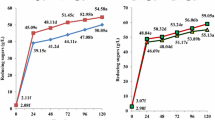Sweet potato residue, a starchy agricultural waste, was used as a substrate to produce microbial protein by Fusarium moniliforme and Saccharomyces cerevisiae in submerged fermentation. Acid- and gamma-irradiation-pretreated sweet potato residue enhanced the biomass yield and protein production when the residue was fermented with F. moniliforme and S. cerevisiae. A mixed culture of F. moniliforme and S. cerevisiae efficiently and rapidly utilized free sugars; the maximal biomass yield (13.96 g/l) and protein production (65.8%) were obtained after 3 days fermentation. Lower carbon utilization by the two microbial strains occurred in the waste-containing media as compared to control, increasing the economic value of the waste usage.
Similar content being viewed by others
Author information
Authors and Affiliations
Additional information
Received 25 October 2001/ Accepted in revised form 22 June 2002
Rights and permissions
About this article
Cite this article
Aziz, N., Mohsen, G. Bioconversion of acid- and gamma-ray-treated sweet potato residue to microbial protein by mixed cultures. J Ind Microbiol Biotech 29, 264–267 (2002). https://doi.org/10.1038/sj.jim.7000297
Issue Date:
DOI: https://doi.org/10.1038/sj.jim.7000297




